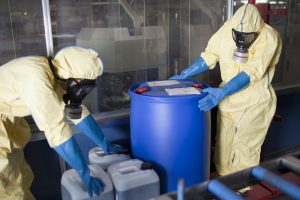Hazardous waste generators are allowed to accumulate small amounts of hazardous waste in locations at or near the point of generation where wastes initially accumulate. These satellite accumulation areas (SAA) must be under the control of the person operating the process generating the hazardous waste.
“Both large quantity generators (LQGs) and small quantity generators (SQGs) may accumulate hazardous waste in SAAs, provided it is managed in accordance with all the provisions of 40 CFR section 262.15,” according to the EPA’s Hazardous Waste Generation FAQs website.
Generator defined
The EPA’s website defines a generator as “any person, by site, whose act or process produces hazardous waste identified or listed in part 261 or whose act first causes a hazardous waste to become subject to regulation (40 CFR section 260.10). The generator of a waste may not necessarily be the person who actually produced the waste. For example, a contractor who removes hazardous residues from a product storage tank is the first person to cause the waste to become subject to regulation, rather than the owner of the tank. Although the person removing the waste from the unit is not the owner or operator of the unit, he or she may be considered a generator. The owner or operator of the unit may also be considered a generator since the act of operating the unit led to the generation of the hazardous waste. In other words, both the person that removed the waste and the owner or operator of the tank are considered to be co-generators. In cases where one or more persons meet the definition of generator, all persons are jointly and severally liable for compliance with the generator regulations (45 FR 72024, 72026; October 30, 1980).”
How much waste can be stored at SAAs?
Generators can accumulate up to 55 gallons of nonacute hazardous waste and/or either 1 quart of liquid acute hazardous waste or 1 kilogram (kg) of solid acute hazardous waste at each SAA under the control of the operator.
The preamble of the Hazardous Waste Generator Improvements Rule defines “under the control of the operator” as “the operator controls access to an area, building, or room in which the SAA is located, such as with entry by access card, key or lock box. Another example is if the operator accumulates waste in a locked cabinet and controlled access to the key, even if the cabinet is stored inside a room to which access is not controlled.”
Regulations relating to storage standards for hazardous waste, such as labeling, closed containers, and containers that are in good condition, apply to waste stored in SAAs.
“Once the generator exceeds the volume limits, the excess waste must be dated and moved within three consecutive calendar days to the central accumulation area (CAA),” states the EPA. “At the CAA, the waste must be managed in accordance with the more comprehensive hazardous waste accumulation standards in section 262.16(b) for SQGs or section 262.17(a) for LQGs.”
It is important to note that all hazardous waste stored in the various SAAs must be included when calculating generator categories.
SQGs can store hazardous waste “for 270 days without a permit if the distance to the designated off-site treatment, storage, or disposal facility is 200 miles or greater, provided they follow the accumulation requirements in section 262.16(c),” according to the EPA.
Generator categories
- Very small quantity generators create no more than 1 kg of acute hazardous waste, no more than 100 kg of nonacute hazardous waste, and no more than 100 kg of residues from hazardous waste cleanup in a calendar month.
- SQGs create no more than 1 kg of acute hazardous waste, between 101 and 999 kg of nonacute hazardous waste, and no more than 100 kg of residues from hazardous waste cleanup in a calendar month.
- LQGs are classified as those that create more hazardous waste in any of the above amounts listed for SQGs.
LQGs have no maximum limits on the amount of hazardous waste generated but are subject to standards for managing that waste, accord to 40 Code of Federal Regulations (CFR) Section 262.17. For example, there are limits on the length of time waste can be stored in a CAA (up to 90 days) and the types of containers used to store the hazardous waste.

